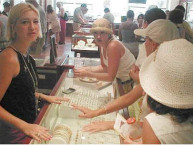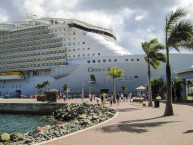Coral

Coral has been a popular jewelry medium since antiquity. 13th century explorer Marco Polo noted the use of Coral for fashioning idols in Asian Temples, and since then the popularity of Coral has not waned. There has been a coral trade between Naples, Italy, and Marseille, France, for thousands of years, while a number of the ancient towns buried by Mount Vesuvius eruptions were known for coral work and cameo-making.
Generally Coral is most popular in the tropical climates. Without a doubt,  this is the jewelry that really accentuates a fine tan. Match this with color floral prints on silk and the picture is complete. If you winter in South Florida , Hawaii , live aboard a fine sailboat or merely want to look as if you do, then Coral is for you.! The most popular look for Coral right now is strands and strands of perfectly matched coral beads. Matching ear-rings complete the look.
this is the jewelry that really accentuates a fine tan. Match this with color floral prints on silk and the picture is complete. If you winter in South Florida , Hawaii , live aboard a fine sailboat or merely want to look as if you do, then Coral is for you.! The most popular look for Coral right now is strands and strands of perfectly matched coral beads. Matching ear-rings complete the look.
Mediterranean Coral has long been held by experts to be the finest. The supply of Mediterranean red coral is diminishing, and divers are going deeper and deeper, at greater risk to themselves. Some dealers report that Italy is even restricting diving for red coral.
Black coral, which is a plant, comes from Mexico and the Caribbean. Black coral grows in all oceans and is one of about 150 species of coral that live in tropical waters, normally at a depth of less than 300 feet. Black coral does not form reefs or heads, and instead resembles a tree growing on the ocean floor. This rare coral, in its live form, looks nothing like the jewelry. The exterior sheath of this plant-like creature is usually an earth tone of green, gold or tan rather than black. Tiny, delicate polyps branch off thin stems like fern fronds, camouflaging the hard core inside. Most black coral trees spread to about 1 meter (3 ft) in diameter. Even at this size, the stems are quite small. It takes quite an aged colony to produce stems large enough to make jewelry. A 4-foot black coral is about 20 years old.
A wonderful blush pink coral named “angel skin” comes from the South Pacific. Not as high a quality of Coral as the Mediterranean Coral, however the color is popular with young women, so the price has been driven up dramatically over the past several years.
comes from the South Pacific. Not as high a quality of Coral as the Mediterranean Coral, however the color is popular with young women, so the price has been driven up dramatically over the past several years.
Color is the main value factor of coral. Oxblood-red coral is the most expensive, followed by salmon, angel-skin, white, and black coral. Most experts also consider intensity  and uniformity of color to be a major factor. The material should be free of spots, cracks, inclusions, or holes of any kind.
and uniformity of color to be a major factor. The material should be free of spots, cracks, inclusions, or holes of any kind.
Coral is often dyed to enhance it. To detect the presence of dye, use a drop of nail polish remover on a cotton swab and test the under side of the coral. If the color comes off on the swab, the coral has been dyed. To test for genuine coral, place one drop of vinegar on the coral carefully. If it is genuine the acid will cause the coral to effervesce.
Coral polish should be excellent. Some traders will mask poor coral by using wax to produce a shine so be alert. Strands of coral beads should be uniform in size, unless it is of graduated beads. Bead holes should be drilled directly through the middle of the bead so they lie on the neck properly.
Round bead necklaces are the most expensive of coral necklace shapes, & will vary in price according to color and grade.
Because Coral is an organic substance which take years and years to grow it is an endangered resource. Many of the wonderful coral reefs around the world have taken thousands of years to be formed. The majority of these are protected from harvesting. When shopping for Coral, ask where this piece originated. Again this is a time to deal with reputable Jewelers. A resource which is carefully monitored and harvested within the laws is a thing of beauty and enhances our lives. When natural beauty is destroyed for profit illegally, it hurts us all.
Folklore and Legends of Coral
Coral Jewelry is believed to have stimulating powers on the acuity of the mind. Coral allegedly cures madness and protects against enchantments. In the 16th Century people thought that a sprig of Coral could calm a raging tempest. It was also thought to protect the wearer against evil; children in particular were given coral jewelry to ensure their safety and keep them healthy.



